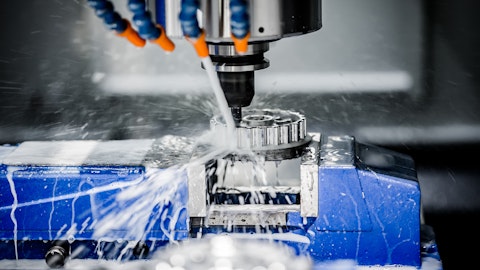Bob Meyers: Great, thank you. There was another question here about cash burn and if you could talk a little bit about what you see going forward.
Judd Merrill: Yeah, as we stated, I think with a couple of questions from before, we have additional CapEx related to the plant. It was one piece, and the other piece is just the ongoing cash needs for OpEx and G&A of about $5 million per quarter.
Bob Meyers: Thank you. Next question, how many tons of black mass is the pilot plant currently processing per week?
Steve Cotton: So, the pilot plant is scaled to be one-thirtieth of the size of the production plant. So that allows us to really operate around 50 tons to 100 tons per year of processing capacity. And that capacity is black mass input. And we’ll continue to take those materials that we’re already producing from the pilot and using that for samples and sample quantities, which are significant. They’re not in grams or kilograms, but more than that, to the various folks in the industry. So that’s really the purpose of the pilot is to produce those materials and get those into the hands of all the various announced and then ultimately unannounced partners so they can evaluate and qualify the materials that will be coming out of the Sierra-ARC when that comes online.
Bob Meyers: Great, thank you. What is the typical lithium yield from 1 ton of black mass?
Steve Cotton: Yes, the easy but confusing answer is, it depends. And it depends upon the makeup of the material. What’s really great about our technology is that, we’ve been able to process lithium maybe with a 5% composition in the black mass to maybe a little bit more than that, all the way to a much higher percentage in things like cathode powder. So we’re very flexible in the types of recipes that come. It’s a whole alphabet of letters, NMZ or LFP or LMMP and other mixes of the materials. So we’re very flexible in the way we do it, but the important aspect of what we do is we extract a very high 90% of the lithium right out of whatever those sources are from those various battery recipes. That’s really important because if you compare that to pyro or smelting that recovers 0% of the lithium, that is a great economic advantage that we have compared to those types of incumbent applications that are out there.
Much better economics and, of course, it’s probably a good idea not to burn lithium and put it into the air, but rather to capture it and reuse it over and over infinitely.
Bob Meyers: Thank you. Next question. How many times can you recycle the precious metals in a typical lithium ion battery without losing their efficacy?
Steve Cotton: Yes, so that’s the beauty of these critical minerals recovery is all of these various critical minerals can be used over and over and over again infinitely. So once you reuse it once, you’re certainly ahead of oil and gas where you can’t recycle gasoline and oil, but you can recycle these minerals and you can’t recycle plastics more than multiple times and then it starts to degrade the very complex molecules, the plastics. But these are atoms, and we’re recovering them 1 atom at a time in a very pure form. And that allows for an infinite recycling and closing of the loop, with the idea broadly of digging things up once, processing them, getting them into batteries and then reusing them over and over and over again.
As students of history, as we look at the lead market, in the lead battery market, if you buy a brand new lead battery today, it’s going to have 80%, 90% or so of recycled lead and even other materials like copper and plastics that are in it. Lithium batteries today are close to 0% to 1% and over time as the recycling begins to close the loop and build that supply chain, it’s going to migrate from that 0% to 1% up towards ultimately as the market matures in probably a couple more decades to those high percentages of recycled material that’s infinitely recycled over and over.
Bob Meyers: Right. Thank you. Thanks Steve. Next question, despite some of the progress and opportunities that you’ve outlined, there still has been some headwinds in the market and the way the stock trades a little bit. What do you believe to be the disconnect and what milestones can we look for in the coming year to further investor confidence in the company?
Steve Cotton: Sure, so there’s investor confidence generally in the industry and then in the company. I’ll do it in that order. So if you look at investor confidence in the industry, we have seen metals prices come down. We have seen some misleading articles about EVs being a fad and this really isn’t going to grow and a halt of production and things like that. But when you look at the facts and you look at the data, we’ve seen 30% year-over-year growth in EVs just in 2023. We’ve seen in the January report for 2024 continued growth. We’ve seen the first time that well over a million EVs were sold in the US, which has a lower market penetration percentage of other places throughout the world like EU and certainly in China with higher EV penetrations.
The EV manufacturers would be at big auto or emerging EVs know that by 2030 it’s going to cost them less to make electric vehicles than it’s going to cost them to make internal combustion engine vehicles because of the cost of managing a supply chain and the cost of goods sold. So for the consumers, the performance to price ratio is already pretty much equalized, and we expect it will continue to grow. So all evidence and real data points towards an inevitability in this industry. And I keep talking about auto, but then there’s also energy storage like solar and wind and all the gigafactories that we talked about on the call earlier today in the US expanding by 200 times over what 2020 was. That is a whole industry that [indiscernible] recycling and needs the loop to be closed.



